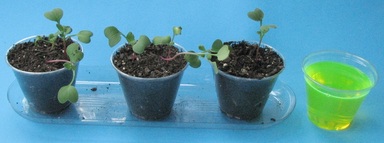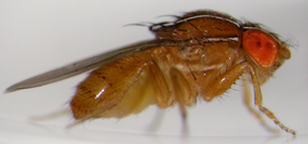
The next project on this page will be a homemade centrifuge for $5!!!
| Observations |
|
 I try quite a few experiments and frequently have unexpected results. This can sometimes be construed as failure, but I tend to think of the things that go wrong to be as important as the things that go right. This experiment falls into this category of investigation.My initial question was whether or not I could introduce a fluorescent dye into a growing plant and track the fluorescence from root to leaf. I used the fluorescent dye fluorescein, that is found in Sharpie Highlighters. (To see how to extract the dye, go to the Odds 'n Ends page and look for "Neon" in the archive). Although we already know that chlorophyll is fluorescent, it is tied together with other molecules and does not show its glow. I am working on that experiment as well. But the video explains my experiment fairly well. However, there are two corrections to note: 1- The middle plant that died from infestation received 25 milliliters of diluted dye, not 50 as I said in the video, but the third plant did receive 50 milliliters. 2- The white impatiens died overnight and could not be photographed. However, search for "fluorescent flowers" and you can see what others have done with the color white in carnations and geraniums. The next project on this page will be a homemade centrifuge for $5!!!
0 Comments
 Fruit flies, also known as Drosphilia Malanogaster, have been studied for over sixty years. They are easy to raise, grow, and study for their genetic tendencies. The female lays about 500 eggs, a few at a time, in rotting fruit or other suitable locations. The eggs hatch quickly, in 15 to 24 hours and the the larvae begin to feed on the sugar in the fruit. At least that is what we thought! Then, after about four days, the larvae encapsulates in the puparium, and then emerges as an adult. The entire life cycle is about 30 days, depending on temperature. But, all of the time we have thought that the larvae were feeding on sugar and microorganisms, has now been challenged. Roshan Vijendravarma, of the University of Lausanne, Switzerland, and his colleagues have observed larvae eating older and fatter larvae. The most important part of this observation is that it is a behavior that has been unknown. It suggests that we can still find surprises, even in well studied species. The fruit fly like other flies, is of the order Diptera, and has mufti-faceted eyes. I have included photos of the well known red eyes at 20 and 40 power on my microscope below. As a side point, if you want to exterminate them, here is a good way to do so: Place two tablespoons of cider vinegar in a dish with one quarter teaspoon of dish soap, any kind and mix well. The cider vinegar will attract them, and the soap traps them from leaving by wetting their bodies making them unable to fly. Here's looking at you! |
AuthorThe author has an eclectic background in chemistry, electronics, writing, mental health, and community action...Ken Archives
June 2021
|